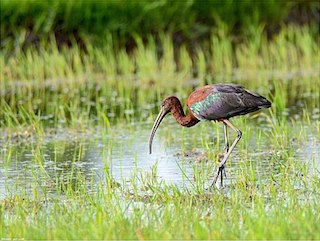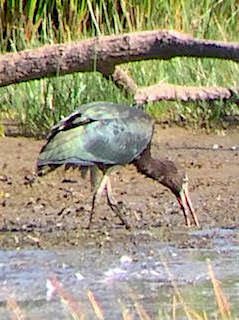 This beautiful wader used to be considered a vagrant, but is becoming a more common, if still occasional, migratory visitor. Croft Pascoe Pool, on Goonhilly Downs is a good place to spot one.
This beautiful wader used to be considered a vagrant, but is becoming a more common, if still occasional, migratory visitor. Croft Pascoe Pool, on Goonhilly Downs is a good place to spot one.
Photo: Freddie
Scientific name: Plegadis falcinellus
Other common names: Black Curlew
Conservation status: UK conservation status, Not Assessed; IUCN, Least Concern
What to look for:
• Colouring and appearance: Breeding plumage: deep chestnut on head, neck, back and underparts; with a metallic, purple-bronze sheen on the lower back, tail and wings. Dark legs and long, slender, curving bill. Blue-black skin on face between bill base and eye, with paler blue edign above and below. Non-breeding pumage is duller, and with white streaks on the head and neck. Females are smaller than males.
• Size: Wingspan 80 to 95 cm, length 48 to 66 cm.
• Where: This is the most widely distributed of the Ibis species, ranging from Eurasia and Africa, to Australia, the USA and central America. Increasing (though still relatively small) numbers overwinter in the UK.
• Call: Croaks and grunts
 The Glossy Ibis is always a thrilling bird to see. That slender, long and down-curved bill, its bronze-purple breeding plumage, those long legs sedately and slowly picking their way through the shallow waters of a pool or marsh as the bird searches the water for its food (mainly invertebrates and small vertebrates)…all contribute to its distinctive and darkly exotic looks. Seen in silhouette, it looks almost black, but get closer and you’ll see the glossy sheen that gives it its common name (this is less obvious, but still visible, in non-breeding plumage).
The Glossy Ibis is always a thrilling bird to see. That slender, long and down-curved bill, its bronze-purple breeding plumage, those long legs sedately and slowly picking their way through the shallow waters of a pool or marsh as the bird searches the water for its food (mainly invertebrates and small vertebrates)…all contribute to its distinctive and darkly exotic looks. Seen in silhouette, it looks almost black, but get closer and you’ll see the glossy sheen that gives it its common name (this is less obvious, but still visible, in non-breeding plumage).
The Glossy Ibis is migratory, and birds seen in the UK may possibly be heading to or from their breeding grounds in southern Spain. It used to be much rarer here, and was considered a vagrant, but is becoming more common, with overwintering birds arriving in the autumn. It has even been removed from the British Birds Rarities Committee list (in 2013).
 The species breeds in large colonies with other species. Males and females share in both nest-building and incubation duties – the nest is made of twigs, close to the ground and close to water, and the clutch consists of three to four eggs. The young fledge almost a month after hatching, and are fully independent after about six to seven weeks.
The species breeds in large colonies with other species. Males and females share in both nest-building and incubation duties – the nest is made of twigs, close to the ground and close to water, and the clutch consists of three to four eggs. The young fledge almost a month after hatching, and are fully independent after about six to seven weeks.
Did you know…?
…The Glossy Ibis has a bilingual name: its genus and species name both refer to the bird’s long, down-curved bill, and are derived from Ancient Greek and Latin, respectively. Plegadis (from plegados) and falcinellus (from falcis) both mean ‘sickle’ or ‘scythe’.
More information and references:
Svensson, L., Mullarney, K., Zetterstrom, D.,1986. Collins Bird Guide, second edition (translated by Christie, D., Svensson, L.). HarperCollins, London.
Published: September 2018
Author: Amanda Scott
Photos: Lower: Glossy Ibis seen at Croft Pascoe Pool (photo by Freddie); upper: By Manojiritty [CC BY-SA 4.0]
